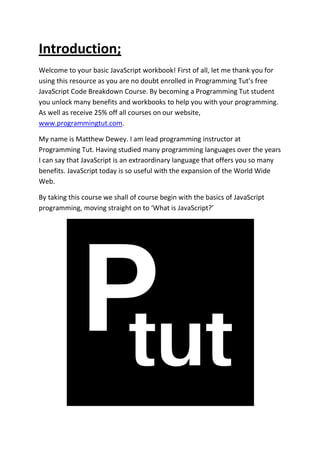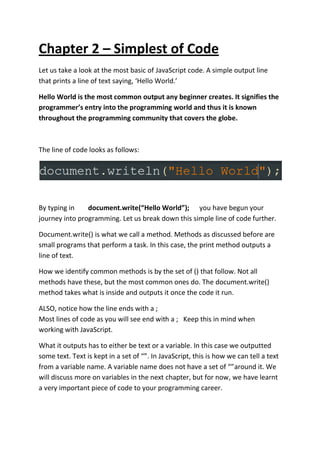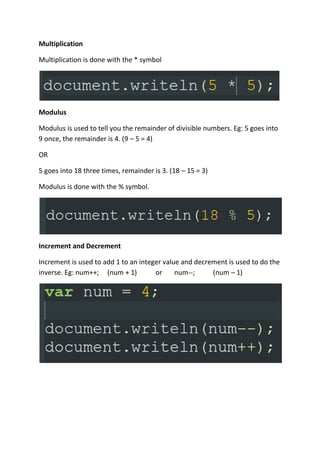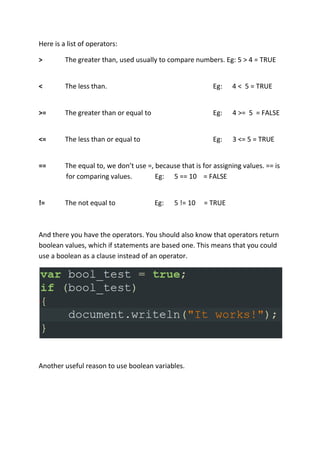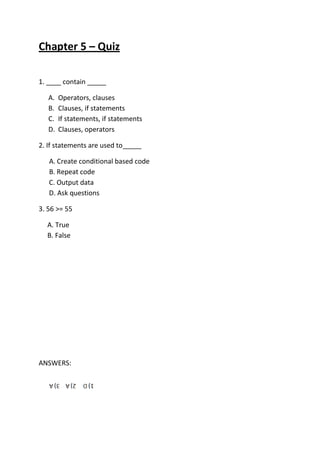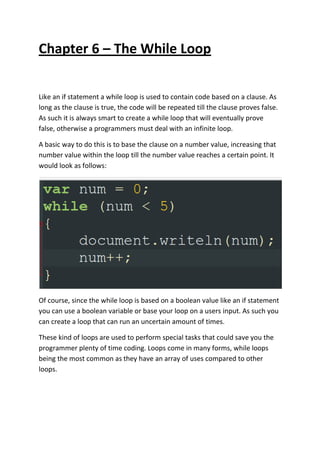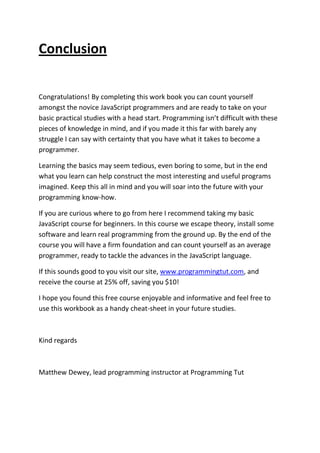Javascript breakdown-workbook
- 2. Introduction; Welcome to your basic JavaScript workbook! First of all, let me thank you for using this resource as you are no doubt enrolled in Programming Tut’s free JavaScript Code Breakdown Course. By becoming a Programming Tut student you unlock many benefits and workbooks to help you with your programming. As well as receive 25% off all courses on our website, www.programmingtut.com. My name is Matthew Dewey. I am lead programming instructor at Programming Tut. Having studied many programming languages over the years I can say that JavaScript is an extraordinary language that offers you so many benefits. JavaScript today is so useful with the expansion of the World Wide Web. By taking this course we shall of course begin with the basics of JavaScript programming, moving straight on to ‘What is JavaScript?’
- 3. Chapter 1 - What is JavaScript?; JavaScript is one of the three core technologies of the World Wide Web. As such it is an infinitely important programming language that any programmer can benefit from learning. JavaScript claims its fame through the amazing developments it has made in web development and will continue to JavaScript was first introduced in 1995. During this time it grew in popularity and took the world by storm. JavaScript became the most common tool next to Python in web development. Many programs and website based services make use of JavaScript. As you can imagine this is a huge triumph for any programming language, but what takes it further is that large companies such as Google and YouTube make use of JavaScript. Brendan Eich, the developer of JavaScript, soon made millions of dollars, co- founded Mozilla and constantly works with JavaScript. This year, 2018, a stable release of JavaScript lead to a spike in JavaScript programmers, making it a truly outstanding development in programming. Today, JavaScript is the most used programming language, shortly followed by Python. However, the gap between the two is only closing as Python grows more in popularity. However, experienced programmers know that the importance of JavaScript to the WWW will always make it the leading programming in the world. What we can say for sure is that JavaScript will always be a needed language and its programmers the most highly paid.
- 4. Chapter 1 – Quiz 1. Who developed the JavaScript programming language? A) Steve Jobs B) Brendan Eich C) Kim Knapp D) Bill Gates 2. Which year was JavaScript released? A) 2018 B) 1990 C) 2000 D) 1995 3. “JavaScript is the ___ used language.” A) Second-most B) Third-most C) Most D) Fifth-most ANSWERS:
- 5. Chapter 2 – Simplest of Code Let us take a look at the most basic of JavaScript code. A simple output line that prints a line of text saying, ‘Hello World.’ Hello World is the most common output any beginner creates. It signifies the programmer’s entry into the programming world and thus it is known throughout the programming community that covers the globe. The line of code looks as follows: By typing in document.write(“Hello World”); you have begun your journey into programming. Let us break down this simple line of code further. Document.write() is what we call a method. Methods as discussed before are small programs that perform a task. In this case, the print method outputs a line of text. How we identify common methods is by the set of () that follow. Not all methods have these, but the most common ones do. The document.write() method takes what is inside and outputs it once the code it run. ALSO, notice how the line ends with a ; Most lines of code as you will see end with a ; Keep this in mind when working with JavaScript. What it outputs has to either be text or a variable. In this case we outputted some text. Text is kept in a set of “”. In JavaScript, this is how we can tell a text from a variable name. A variable name does not have a set of “”around it. We will discuss more on variables in the next chapter, but for now, we have learnt a very important piece of code to your programming career.
- 6. Chapter 2 – Quiz 1. What kind of method is the document.writeln() method? A) Input method B) Data method C) Output method D) Void method 2. Which of these is NOT text? A) “1234” B) ‘Hi’ C) True D) ‘I’ 3. What is the result of this code: document.writeln(“Hello” + “World”); A. HelloWorld B) Hello World C) Hello + World D) Hello World Answers:
- 7. Chapter 3 – Data Types and Variables When you studied mathematics you no doubt learned there are different number types. Real numbers, rational, irrational and so on. Well, like number types there are also different data types. There are four data types we will be discussing. Strings, integers, floats and booleans. Strings You have already encountered strings. Strings are lines of text, lines of text being one or more characters encapsulated in “” or more commonly ‘’. Eg: “John grew up on a farm” “123 & 124” Integers Integers are whole numbers ranging from negative infinity to positive infinity. Eg: -72983 93747 33
- 8. Floats Floats have a similar, but far larger range than that of integers. Floats range from the negative infinity to positive infinity as well, but include all decimal point numbers as well. Eg: 56.898 129730750237507.0232414 1.0 Boolean Boolean is a special data type. It has two values. True and False, or in machine code, 1 and 0. Variables Variables in programming are the same as variables in mathematics. Variables are containers for values of any data type. To create a variable you simply type what you want to call it. Before we do that, let’s go over some naming conventions. 1. You do not use special characters (#$%^&*etc) or numbers (23456etc) 2. You do not use spaces, but rather, underscores ( _ ) 3. Use lower case letters 4. Be smart naming, descriptive Eg: var name var first_name var this_is_a_very_specific_variable
- 9. Here is an example of assigning a value to a variable: Now let us take a look at overwriting some variables. Notice how all variables can be overwritten, so be careful in your variable creation when working with larger numbers. You don’t want to reuse a variable thinking it is the first time you created it. In this code you see me overwrite a variable containing a string with an integer.
- 10. Chapter 3 – Quiz 1. Which is a valid variable name? A. document.write B. hello C. I_am_1 D. this_is_a_great name 2. Which is not a correct way to assign a variable a value? A. var name = 56 B. var num is 10 C. var num = “Hello”; D. var bool = True 3. Which data type will this variable be: var num = 5.67; A. Float B. Integer C. String D. Boolean ANSWERS:
- 11. Chapter 4– Programming Mathematics Mathematics in programming has small changes compared to real mathematics done on a piece of paper or in a calculator. Here are the basic math functions you need to know. BODMAS applies in programming. Addition Addition is done with the + symbol Subtraction Subtraction is done with the – symbol Division Division is done through the / symbol (notice integer is no float)
- 12. Multiplication Multiplication is done with the * symbol Modulus Modulus is used to tell you the remainder of divisible numbers. Eg: 5 goes into 9 once, the remainder is 4. (9 – 5 = 4) OR 5 goes into 18 three times, remainder is 3. (18 – 15 = 3) Modulus is done with the % symbol. Increment and Decrement Increment is used to add 1 to an integer value and decrement is used to do the inverse. Eg: num++; (num + 1) or num--; (num – 1)
- 13. Chapter 4 – Quiz 1. What is the result of: 5-- A. 6 B. 0 C. 4 D. 3 2. What is the result of: 25 % 6 A. 1 B. 2 C. 5 D. 4 3. What is the result of: (5*5-6) + 5 A. 25 B. 89 C. -6 D. 24 ANSWERS:
- 14. Chapter 5 - If Statements If statements are used to check data before running code. If statements make use of operators and clauses to see if values prove true before running code. For example, say you want to print ‘hello’, but only if another value is equal to ‘hello’. Your if statement would look like: An if statement is structured as follows. if (clause is true) { (run following code) } Clauses make use of operators which are characters or sets of characters used to compare to values. In the clip above we compared greets value to ‘hello’. The clause proved true and the code ran. However, if it was different even slightly, like let’s say greet used an uppercase H instead of lowercase, the clause would be false. Hello does not equal hello.
- 15. Here is a list of operators: > The greater than, used usually to compare numbers. Eg: 5 > 4 = TRUE < The less than. Eg: 4 < 5 = TRUE >= The greater than or equal to Eg: 4 >= 5 = FALSE <= The less than or equal to Eg: 3 <= 5 = TRUE == The equal to, we don’t use =, because that is for assigning values. == is for comparing values. Eg: 5 == 10 = FALSE != The not equal to Eg: 5 != 10 = TRUE And there you have the operators. You should also know that operators return boolean values, which if statements are based one. This means that you could use a boolean as a clause instead of an operator. Another useful reason to use boolean variables.
- 16. Chapter 5 – Quiz 1. ____ contain _____ A. Operators, clauses B. Clauses, if statements C. If statements, if statements D. Clauses, operators 2. If statements are used to_____ A. Create conditional based code B. Repeat code C. Output data D. Ask questions 3. 56 >= 55 A. True B. False ANSWERS:
- 17. Chapter 6 – The While Loop Like an if statement a while loop is used to contain code based on a clause. As long as the clause is true, the code will be repeated till the clause proves false. As such it is always smart to create a while loop that will eventually prove false, otherwise a programmers must deal with an infinite loop. A basic way to do this is to base the clause on a number value, increasing that number value within the loop till the number value reaches a certain point. It would look as follows: Of course, since the while loop is based on a boolean value like an if statement you can use a boolean variable or base your loop on a users input. As such you can create a loop that can run an uncertain amount of times. These kind of loops are used to perform special tasks that could save you the programmer plenty of time coding. Loops come in many forms, while loops being the most common as they have an array of uses compared to other loops.
- 18. Chapter 6 – Quiz 1. While loops can run ____ times A) 5 B) 10 C) 9,000,000 D) Infinite 2. While loops are ____ A) Obsolete B) Common C) Often encountering errors D) Unstable 3. While loops are ____ if statements A) Similar to B) Unlike C) The same as D) The opposite of ANSWERS:
- 19. Chapter 7 – Errors You will encounter three different types of errors in JavaScript programming. Syntax, logical and exceptions. Syntax Errors Syntax errors are common errors that will arise from a character out of place or perhaps from misspellings. Syntax errors only occur in this form and not through your actual code structure. As such these errors are the easiest to solve. Logic Errors Logic errors come from a structure in your code. Unlike syntax errors these errors are hard to find, making them one of the worst errors that you can encounter in your JavaScript programming. These errors are often solved using debuggers. Exceptions Exceptions come from JavaScript being able to decipher the code, but unable to run it due to more hidden reasons beyond the programming. For example, trying to access a file that isn’t there or to access the internet with no internet connection. These are the common forms of exception error.
- 20. Chapter 7 – Quiz 1. Identify the error: Attempting to divide a variable, but it contains no value. A) Syntax B) Logical C) Exception D) No error 2. Identify the error: Reading a text file, but misspelling in file name A) Syntax B) Logical C) Exception D) No Error 3. Identify the error: document.wrte(“Hello World”); A) Syntax B) Logical C) Exception D) No error ANSWERS:
- 21. Conclusion Congratulations! By completing this work book you can count yourself amongst the novice JavaScript programmers and are ready to take on your basic practical studies with a head start. Programming isn’t difficult with these pieces of knowledge in mind, and if you made it this far with barely any struggle I can say with certainty that you have what it takes to become a programmer. Learning the basics may seem tedious, even boring to some, but in the end what you learn can help construct the most interesting and useful programs imagined. Keep this all in mind and you will soar into the future with your programming know-how. If you are curious where to go from here I recommend taking my basic JavaScript course for beginners. In this course we escape theory, install some software and learn real programming from the ground up. By the end of the course you will have a firm foundation and can count yourself as an average programmer, ready to tackle the advances in the JavaScript language. If this sounds good to you visit our site, www.programmingtut.com, and receive the course at 25% off, saving you $10! I hope you found this free course enjoyable and informative and feel free to use this workbook as a handy cheat-sheet in your future studies. Kind regards Matthew Dewey, lead programming instructor at Programming Tut

